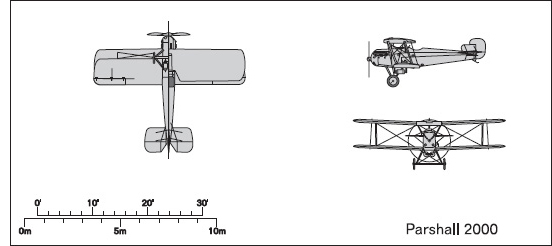
This appendix is divided into two sections: early aircraft and aircraft of the Pacific War. The first section lists the principal combat aircraft types found in the Imperial Japanese Navy from 1921 until the outbreak of the Pacific War. In most cases the aircraft illustrated is the last variant of a given model. The second section lists the principal combat aircraft types in the Imperial Japanese Navy designed and in production at the outbreak of the war on 8 December 1941. In those cases where an aircraft had multiple active variants (including noncombatant variants such as trainers and transports), only the latest combat variant fielded at the outbreak of the war is listed.
Each aircraft listed here is identified with the symbol • where first discussed in the text. Information for this appendix was drawn from the following sources: NKS; Mikesh and Abe, Japanese Aircraft; Francillon, Japanese Aircraft; and Hasegawa, Nihon no kōkūbōkan.
FIGHTERS

Fig. A6-1. Mitsubishi 1MF3 Type 10 carrier fighter
Mitsubishi 1MF3
Official designation: |
Type 10 carrier fighter |
Description: |
Single-engined single-seat biplane carrier-borne fighter of wooden construction and fabric covering |
Crew: |
1 |
Power plant: |
300hp Mitsubishi 8-cylinder water-cooled engine |
Armament: |
2 forward-firing fixed 7.7mm machine guns |

Dimensions
Span: |
27ft 10.5in |
Length: |
22ft 7.5in |
Height: |
10ft 2in |
Weight
Empty: |
2,073lb |
Loaded: |
2,821lb |
Wing loading: |
8.438lb/sq ft |
Performance
Maximum speed: |
132mph |
Cruising speed: |
? |
9,843ft in 10min |
|
Service ceiling: |
22,963ft |
Endurance: |
2.5hrs |
NOTES: One of three types of aircraft whose designs were drawn up in the early 1920s with the assistance of British engineers and under Mitsubishi’s first contract with the navy. The first aircraft to undertake flight operations from the deck of Japan’s first carrier, the Hōshō.
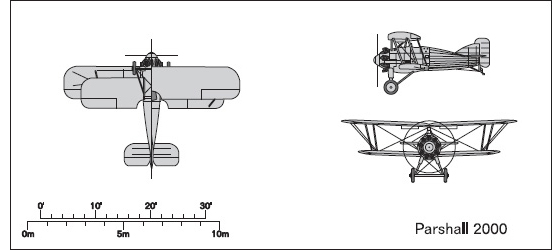
Fig. A6-2. Nakajima A1N1 Type 3 carrier fighter
Nakajima A1N1
Official designation: |
Type 3 carrier fighter |
Description: |
Single-engined single-seat biplane fighter of wooden structure and fabric covering |
Crew: |
1 |
Power plant: |
420hp Nakajima Jupiter VI 9-cylinder air-cooled radial engine |
Armament: |
2 forward-firing side-mounted 7.7mm machine guns |
Bomb load: |
2 × 30kg (66lb) bombs |

Dimensions
Span: |
31ft 9in |
Length: |
21ft 3.5in |
Height: |
10ft 8in |
Empty: |
2,094lb |
Loaded: |
3,196lb |
Wing loading: |
11.3lb/sq ft |
Performance
Maximum speed: |
148mph |
Cruising speed: |
92mph |
Range: |
200nm |
Endurance: |
2.5hrs |
NOTES: This aircraft had its origin in a modified version of the Gloster Gamecock fighter. It was the first Nakajima naval fighter and the best fighter in Japan at the time of its appearance. An improved version, the A1N2, was adopted in 1930. Saw combat during the fighting in Shanghai in February 1932.
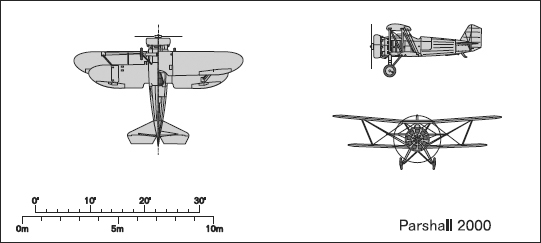
Fig. A6-3. Nakajima A2N1 Type 90 carrier fighter
Nakajima A2N1
Official designation: |
Type 90 carrier fighter |
Description: |
Single-engined single-seat biplane fighter; all-metal fuselage with wood and metal fabric-covered wings |
Crew: |
1 |
Power plant: |
460–580hp Nakajima Kotobuki 2 9-cylinder air-cooled radial engine |
Armament: |
2 forward-firing fixed 7.7mm machine guns |

Span: |
30ft 9in |
Length: |
20ft 3.25in |
Height: |
9ft 11in |
Weight
Empty: |
2,303lb |
Loaded: |
3,417lb |
Wing loading: |
11.3lb/sq ft |
Performance
Maximum speed: |
182mph |
Cruising speed: |
104mph |
Climb: |
9,843ft in 5min 45sec |
Service ceiling: |
29,527ft |
Range: |
270nm |
Endurance: |
3hrs |
NOTES: The first Japanese fighter that was equal in performance to the world’s best fighters of the time. Used by the navy’s acrobatic teams of the early 1930s.
Fig. A6-4. Nakajima A4N1 Type 95 carrier fighter
Nakajima A4N1
Official designation: |
Type 95 carrier fighter |
Description: |
Single-engined single-seat biplane fighter; metal structure with fabric covering |
Crew: |
1 |
Power plant: |
670–730hp Nakjajima Hikari 1 9-cylinder air- cooled radial engine |
Armament: |
2 forward-firing fixed 7.7mm machine guns |
Bomb load: |
2 × 30kg or 60kg (66lb or 132lb) bombs |

Dimensions
Span: |
32ft 9.5in |
Length: |
21ft 9.25in |
Height: |
10ft 1in |
Weight
Empty: |
2,813lb |
Loaded: |
3,380lb |
Wing loading: |
15.74lb/sq ft |
Performance
Maximum speed: |
219mph |
Cruising speed: |
145mph |
Climb: |
9,843ft in 3min 30sec |
25,393ft |
|
Range: |
457nm |
Endurance: |
3.5hrs |
NOTES: Was the navy’s first-line fighter at the opening of the war in China. As the last of the navy’s biplane fighters, it was replaced by the Mitsubishi A5M Type 96 carrier fighter (q.v.).
ATTACK AIRCRAFT
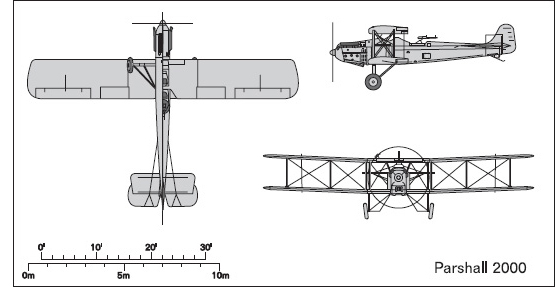
Fig. A6-5. Mitsubishi B1M1 Type 13 carrier attack aircraft
Mitsubishi B1M1
Official designation: |
Type 13 carrier attack aircraft |
Description: |
Single-engined 3-seat biplane attack bomber; wooden structure with fabric covering; rearward-folding wings for carrier stowage |
Crew: |
2 or 3 |
Power plant: |
450 Napier Lion 12-cylinder water-cooled engine |
Armament: |
Twin dorsal flexible 7.7mm machine gun and 2 forward-firing 7.7mm machine guns |
Bomb load: |
1 × 18in torpedo or 2 × 240kg (529lb) bombs |
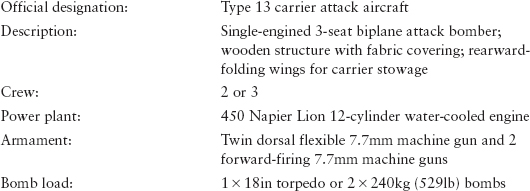
Span: |
48ft 5.5in |
Length: |
32ft 1in |
Height: |
11ft 6in |
Weight
Empty: |
3,179lb |
Loaded: |
5,945lb |
Wing loading: |
9.339lb/sq ft |
Performance
Maximum speed: |
130mph |
Service ceiling: |
14,763ft |
Climb: |
9,843ft in 20min (Type 13-2) |
Endurance: |
2.6hrs |
NOTES: Adopted by the navy in the late 1920s, this aircraft remained the navy’s all-round combat aircraft until the beginning of Japan’s war in China.
Fig. A6-6. Mitsubishi B2M1 Type 89 carrier attack aircraft
Mitsubishi B2M1
Official designation: |
Type 89 carrier attack aircraft |
Description: |
Single-engined 2-bay biplane attack bomber; steel and aluminum construction with fabric covering; rearward-folding wings for carrier stowage |
Crew: |
3 |
Power plant: |
650 Mitsubishi Type Hi 12-cylinder water-cooled engine |
Armament: |
1 forward-firing (from fuselage side) 7.7mm machine gun and 1 dorsal flexible 7.7mm machine gun |
Bomb load: |
1 Type 91 or Type 94 torpedo, or 1 × 800kg (1,763lb) bomb |
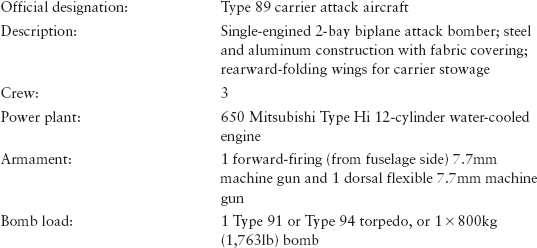
Dimensions
Span: |
49ft 11.25in |
Length: |
33ft 8.5in |
Height: |
12ft 2in |
Weight
Empty: |
4,982lb |
Loaded: |
9,936lb |
Wing loading: |
13.4lb/sq ft |
Maximum speed: |
132mph |
Climb: |
9,843ft in 18 min |
Range: |
960nm |
Endurance: |
? |
NOTES: Adapted from a British Blackburn design, this aircraft was conceived by the navy as a replacement for the Mitsubishi B1M Type 13 carrier attack aircraft (q.v.). Although over two hundred were built between 1930 and 1935, this aircraft was not a success because of stability, engine, and other problems.
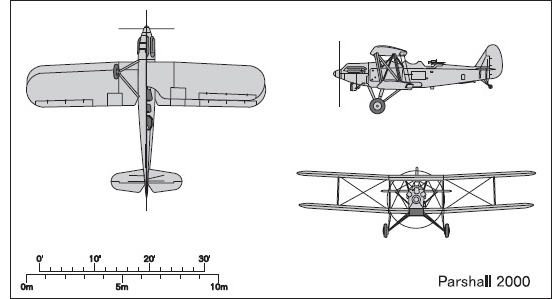
Fig. A6-7. Yokosuka B3Y1 Type 92 carrier attack aircraft
Yokosuka B3Y1
Official designation: |
Type 92 carrier attack aircraft |
Description: |
Single-engined 3-seat biplane attack bomber; welded steel tube fuselage structure with fabric covering; rearward-folding wings for carrier stowage |
Crew: |
3 |
Power plant: |
600–750hp Type 91 12-cylinder water-cooled engine |
Armament: |
1 fuselage-mounted forward-firing fixed 7.7mm machine gun and 1 dorsal flexible 7.7mm machine gun |
1 × 800kg (1,763lb) torpedo, or 2 × 250kg (551lb) bombs, or 6 × 30kg (66lb) bombs |
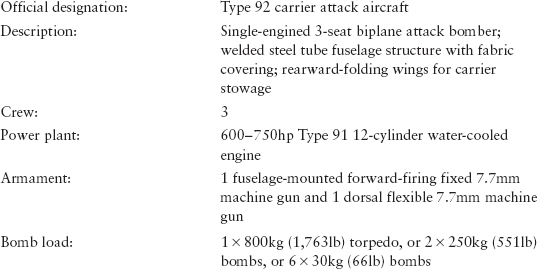
Dimensions
Span: |
44ft 3.25in |
Length: |
31ft 2in |
Height: |
12ft 2.75in |
Weight
Empty: |
4,078lb |
Loaded: |
7,054lb |
Wing loading: |
13.1lb/sq ft |
Performance
Maximum speed: |
136mph |
Endurance: |
4.5hrs |
NOTES: Adopted by the navy in 1933 as a replacement for the Mitsubishi B2M Type 89 carrier attack aircraft (q.v.), this aircraft encountered numerous engine problems. It had a certain success at the beginning of the Japanese war in China, however, in horizontal bombardment against land targets.
Fig. A6-8. Yokosuka B4Y1 Type 96 carrier attack aircraft
Yokosuka B4Y1
Official designation: |
Type 96 carrier attack aircraft |
Subsequent Allied code name: |
“Jean” |
Description: |
Single-engined 3-seat biplane torpedo bomber; all-metal structure with light alloy and fabric covering |
Crew: |
3 |
Power plant: |
600hp Hirō Type 91 air-cooled radial engine |
Armament: |
1 flexible rear-firing 7.7mm machine gun |
Bomb load: |
1 × 800kg (1,764lb) torpedo or 500kg (1,102lb) of bombs |

Dimensions
Span: |
49ft 2in |
Length: |
33ft 3in |
Height: |
14ft 3in |
Weight
Empty: |
4,409lb |
Loaded: |
7,937lb |
Wing loading: |
14.7lb/sq ft |
Maximum speed: |
173mph |
Climb: |
9,845ft in 14 min |
Service ceiling: |
19,685ft |
Range: |
850nm |
NOTES: Acquired in 1936 by the navy as a replacement for the Yokosuka B3Y Type 92 carrier attack aircraft (q.v.), which had proved unreliable. Saw service in the early stages of the China War and operated on Japanese carriers until 1940.
RECONNAISSANCE AIRCRAFT
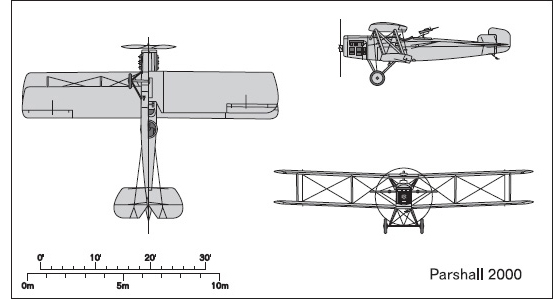
Fig. A6-9. Mitsubishi 2MR1 Type 10 carrier reconnaissance aircraft
Mitsubishi 2MR1
Official designation: |
Type 10 carrier reconnaissance aircraft |
Description: |
Single-engined 2-seat reconnaissance biplane; wooden construction with fabric covering |
Crew: |
2 |
Power plant: |
300hp Mitsubishi 8-cylinder water-cooled engine |
Armament: |
2 forward-firing fixed 7.7mm machine guns and twin dorsal flexible 7.7mm machine guns |
Bomb load: |
3 × 30kg (66lb) bombs |

Span: |
39ft 6in |
Length: |
26ft 0in |
Height: |
9ft 6in |
Weight
Empty: |
2,160lb |
Loaded: |
2,910lb |
Wing loading: |
7.168lb/sq ft |
Performance
Maximum speed: |
127mph |
Climb: |
9,843ft in 17min |
Endurance: |
3.5hrs |
NOTES: This aircraft was acquired by the navy in 1922, and production continued until 1930. After it was withdrawn as an operational aircraft it was used for a number of years as a trainer.
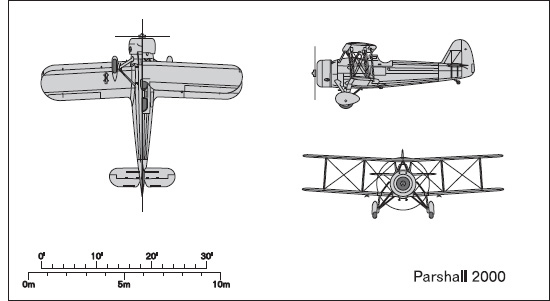
Fig. A6-10. Aichi D1A2 Type 96 carrier bomber
Aichi D1A2
Official designation: |
Type 96 carrier bomber |
Subsequent Allied code name: |
“Susie” |
Description: |
Single-engined 2-seat carrier-borne biplane dive-bomber |
Crew: |
2 (pilot, radio operator/gunner) |
Power plant: |
1 Nakajima Hikari 9-cylinder air-cooled radial, 730hp at takeoff, driving a 2-bladed propeller |
Armament: |
2 fixed forward-firing 7.7mm Type 92 machine guns and 1 flexible rear-firing 7.7mm Type 92 machine gun |
Bomb load: |
1 × 250kg (551lb) bomb under the fuselage and 2 × 30kg (66lb) bombs under the wings |
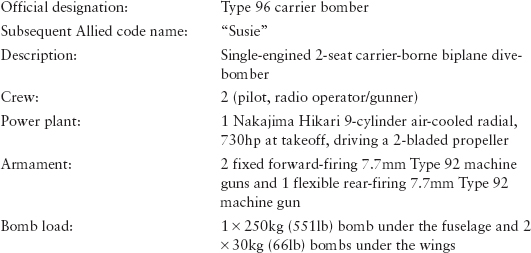
Dimensions
Span: |
37ft 4in |
Length: |
30ft 6in |
Height: |
11ft 2in |
Empty: |
3,342lb |
Loaded: |
5,512lb |
Performance
Maximum speed: |
192mph at 10,500ft |
Cruising speed: |
138mph at 3,280ft |
Climb: |
9,845ft in 7min 51sec |
Service ceiling: |
22,900ft |
Range: |
500nm |
NOTES: This aircraft was originally designated the Aichi D1A1 and was adopted by the navy in 1934 as the Type 94 carrier bomber. In 1935 Aichi designed the improved version of the aircraft shown here, the Aichi D1A2, which was accepted by the navy as the Type 96 carrier bomber. Although it was technically still an active combat aircraft at the outset of the Pacific War, it served in second-line units only.
SECTION 2: AIRCRAFT OF THE PACIFIC WAR
FIGHTERS
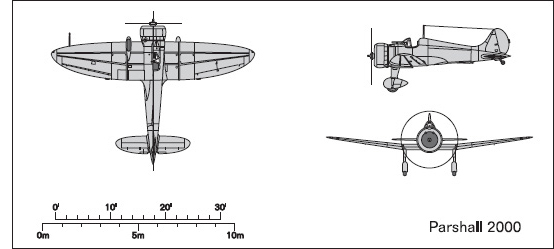
Fig. A6-11. Mitsubishi A5M4 Type 96 carrier fighter
Mitsubishi A5M4
Official designation: |
Type 96 carrier fighter |
Subsequent Allied code name: |
“Claude” |
Description: |
Single-engined single-seat carrier-borne fighter; trainer version (A5M4-K) also produced |
Crew: |
1 |
Power plant: |
1 Nakajima Kotobuki 41 or 41 KAI 9-cylinder air- cooled radial, 710hp at takeoff, driving a 3-bladed propeller |
Armament: |
2 × 7.7mm Type 89 machine guns |
Bomb load: |
2 × 30kg (66lb) bombs or 1 × 160-liter (35.2-imp-gal) drop tank |
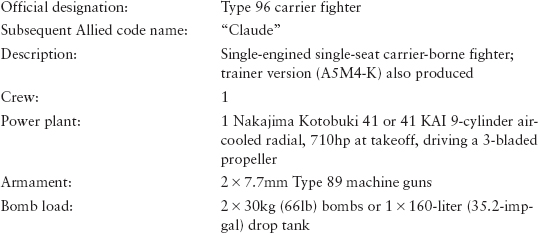
Dimensions
Span: |
36ft 1in |
Length: |
24ft 10in |
Height: |
10ft 6in |
Weight
Empty: |
2,681lb |
Loaded: |
3,684lb |
Maximum speed: |
270mph at 9,845ft |
Climb: |
9,845ft in 3min 35sec |
Service ceiling: |
32,150ft |
Range: |
648nm |
NOTES: Obsolescent but still in use in some front-line units (such as the carrier Ryūjō) during the early portions of the war.
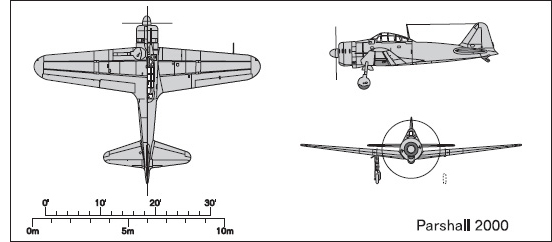
Fig. A6-12. Mitsubishi A6M2 Model 21 Type 0 carrier fighter
Mitsubishi A6M2 Model 21
Official designation: |
Type 0 carrier fighter |
Subsequent Allied code name: |
“Zeke” |
Description: |
Single-engined single-seat carrier-borne and land- based fighter |
Crew: |
1 |
Power plant: |
1 Nakajima NK1C Sakae 12 14-cylinder air- cooled radial, 940hp at takeoff, driving a 3-bladed propeller |
Armament: |
2 × 7.7mm Type 97 machine guns and 2 × 20mm Type 99 cannon |
Bomb load: |
2 × 60kg (132lb) bombs, 1 × 330-liter (72.6-imp- gal) drop tank |
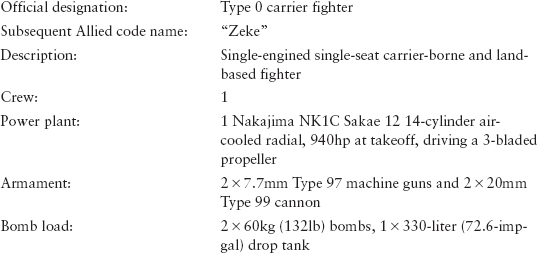
Span: |
39ft 4in |
Length: |
29ft 8in |
Height: |
11ft 6in |
Weight
Empty: |
3,704lb |
Loaded: |
5,313lb |
Performance
Maximum speed: |
332mph at 14,930ft |
Cruising speed: |
207mph |
Climb: |
19,685ft in 7min 27sec |
Service ceiling: |
32,810ft |
Range: |
1,010nm (1,675nm max) |
NOTES: The standard carrier and land-based naval fighter at the outbreak of the war.
ATTACK AIRCRAFT
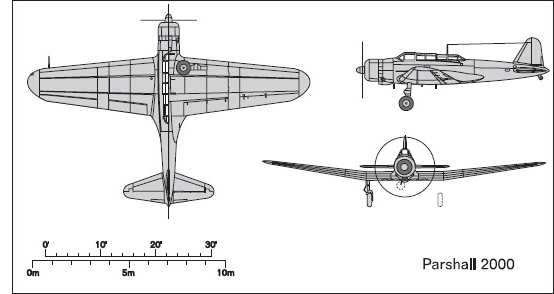
Fig. A6-13. Nakajima B5N2 Type 97 carrier attack aircraft
Nakajima B5N2
Official designation: |
Type 97 carrier attack aircraft |
“Kate” |
|
Description: |
Single-engined 3-seat carrier-borne torpedo bomber |
Crew: |
3 (pilot, observer/navigator/bomb aimer, radio operator/gunner) |
Power plant: |
1 Nakajima NK1B Sakae 11 14-cylinder air-cooled radial, 1,000hp at takeoff, driving a 3-bladed propeller |
Armament: |
1 flexible rear-firing 7.7mm Type 92 machine gun |
Bomb load: |
1 × 800kg (1,764lb) torpedo or 800kg (1,764lb) of bombs |

Dimensions
Span: |
50ft 10in |
Length: |
33ft 9in |
Height: |
12ft 1in |
Weight
Empty: |
5,024lb |
Loaded: |
8,378lb |
Performance
Maximum speed: |
235mph at 11,810ft |
Cruising speed: |
161mph at 11,810ft |
Climb: |
9,845 in 7min 40sec |
Service ceiling: |
27,100ft |
Range: |
528nm (1,075nm max) |
NOTES: At the outbreak of the Pacific War, B5N2s equipped all front-line carrier units. Older B5N1s were still in service in second-line units.
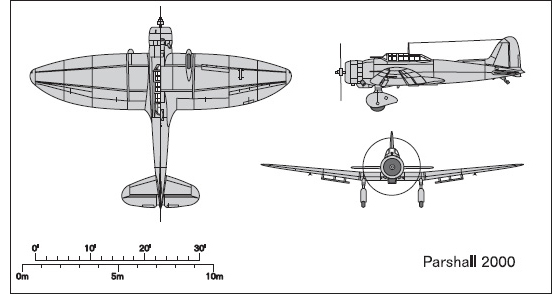
Fig. A6-14. Aichi D3A1 Type 99 carrier bomber
Aichi D3A1
Official designation: |
Type 99 carrier bomber |
Subsequent Allied code name: |
“Val” |
Description: |
Single-engined 2-seat carrier-borne and land-based dive bomber |
Crew: |
2 |
Power plant: |
1 Mitsubishi Kinsei 43 14-cylinder air-cooled radial, 1,000hp at takeoff, or Mitsubishi Kinsei 44 14-cylinder air-cooled radial, 1,070hp at takeoff, driving a 3-bladed propeller |
Armament: |
2 forward-firing 7.7mm Type 97 machine guns and 1 flexible rear-firing 7.7mm Type 92 machine gun |
Bomb load: |
1 × 250kg (551lb) bomb under the fuselage and 2 × 60kg (132lb) bombs under the wings |
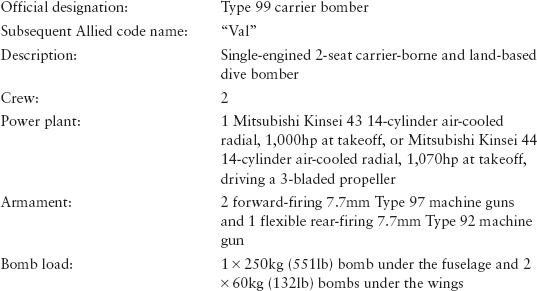
Dimensions
Span: |
47ft 1in |
Length: |
33ft 5in |
Height: |
12ft 7in |
Empty: |
5,309lb |
Loaded: |
8,047lb |
Performance
Maximum speed: |
240mph at 9,845ft |
Cruising speed: |
184mph at 9,845ft |
Climb: |
9,845ft in 6min 0sec |
Service ceiling: |
30,050ft |
Range: |
795nm |
NOTES: D3A1s equipped all front-line carrier dive-bomber formations at the beginning of the Pacific War.
FLOATPLANES
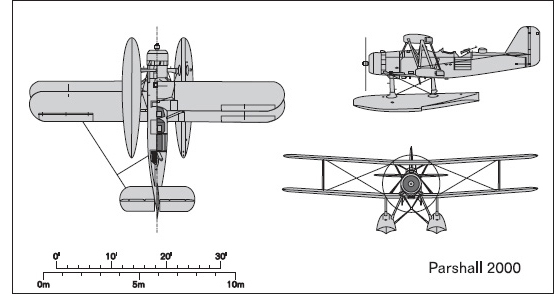
Fig. A6-15. Kawanishi E7K2 Type 94 reconnaissance seaplane
Kawanishi E7K2
Official designation: |
Type 94 reconnaissance seaplane |
Subsequent Allied code name: |
“Alf” |
Description: |
Single-engined 3-seat biplane twin-float reconnaissance seaplane |
Crew: |
3 |
1 Mitsubishi Zuisei 11 14-cylinder air-cooled radial, 870hp at takeoff, driving a 2-bladed propeller |
|
Armament: |
1 forward-firing 7.7mm Type 92 machine gun, 1 flexible rear-firing 7.7mm Type 92 machine gun, and 1 flexible downward-firing 7.7mm Type 92 machine gun |
Bomb load: |
4 × 30kg (66lb) bombs or 2 × 60kg (132lb) bombs |

Dimensions
Span: |
45ft 11in |
Length: |
34ft 5in |
Height: |
15ft 10in |
Weight
Empty: |
4,630lb |
Loaded: |
7,275lb |
Performance
Maximum speed: |
171mph at 6,560ft |
Cruising speed: |
115mph at 3,280ft |
Climb: |
9,845ft in 9min 6sec |
Service ceiling: |
23,165ft |
Endurance: |
11.32hrs |
NOTES: Obsolescent but still used in front-line roles until 1943.
Fig. A6-16. Nakajima E8N2 Type 95 reconnaissance seaplane
Nakajima E8N2
Official designation: |
Type 95 reconnaissance seaplane |
Subsequent Allied code name: |
“Dave” |
Description: |
Single-engined 2-seat biplane reconnaissance seaplane |
Crew: |
2 |
Power plant: |
1 Nakajima Kotobuki 2 KAI 2 9-cylinder air- cooled radial, 630hp at takeoff, driving a 2-bladed propeller |
Armament: |
1 fixed forward-firing 7.7mm machine gun and 1 flexible rear-firing 7.7mm machine gun |
Bomb load: |
2 × 60kg (132lb) bombs |

Dimensions
Span: |
36ft 0in |
Length: |
28ft 10in |
Height: |
12ft 7in |
Weight
Empty: |
2,910lb |
Loaded: |
4,189lb |
Performance
Maximum speed: |
186mph at 9,845ft |
Climb: |
9,845ft in 6min 31sec |
23,850ft |
|
Range: |
485nm |
NOTES: This aircraft appeared in the mid-1930s as a catapult-launched light reconnaissance floatplane operating principally off battleships and cruisers. During the early stages of Japan’s war in China it saw action largely as a reconnaissance aircraft and as a spotter for artillery fire but also occasionally as a dive bomber. After it was replaced early in the Pacific War by more modern floatplanes, it was retained for liaison and training purposes.
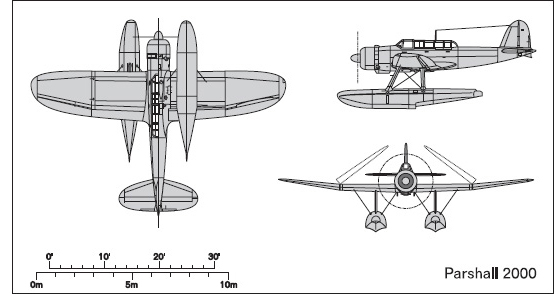
Fig. A6-17. Mitsubishi F1M2 Type 0 observation seaplane
Mitsubishi F1M2
Official designation: |
Type 0 observation seaplane |
Subsequent Allied code name: |
“Pete” |
Description: |
Single-engined 2-seat biplane observation float seaplane; also produced in trainer version (F1M2-K) |
Crew: |
2 (pilot, radio operator/gunner) |
Power plant: |
1 Mitsubishi Zuisei 13 14-cylinder air-cooled radial, 875hp at takeoff, driving a 3-bladed propeller |
Armament: |
2 fixed forward-firing 7.7mm Type 97 machine guns and 1 flexible rear-firing 7.7mm Type 92 machine gun |
Bomb load: |
2 × 60kg (132lb) bombs |
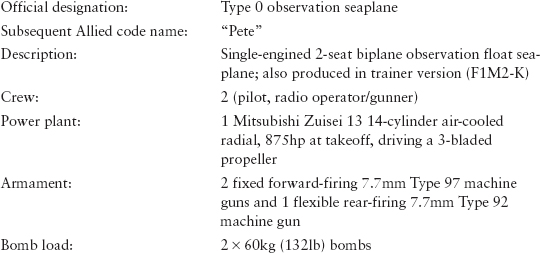
Span: |
36ft 1in |
Length: |
31ft 2in |
Height: |
13ft 1in |
Weight
Empty: |
4,251lb |
Loaded: |
5,622lb |
Performance
Maximum speed: |
230mph at 11,285ft |
Climb: |
16,405ft in 9min 36sec |
Service ceiling: |
30,970ft |
Range: |
400nm |
NOTES: Conceived as a replacement for the Nakajima E8N2 reconnaissance seaplane, this aircraft was produced in large quantities for the navy. It was originally designed as a short-range observation floatplane operating from cruisers, seaplane tenders, and shore bases. But its maneuverability and the exigencies the navy faced in the Pacific War led to its use across a range of functions: interceptor fighter, dive bomber, coastal patrol aircraft, and convoy escort.
Fig. A6-18. Aichi E13A1 Type 0 reconnaissance seaplane
Aichi E13A1
Official designation: |
Type 0 reconnaissance seaplane |
Subsequent Allied code name: |
“Jake” |
Description: |
Single-engined 3-seat twin-float reconnaissance seaplane |
Crew: |
3 |
Power plant: |
1 Mitsubishi Kinsei 43 14-cylinder air-cooled radial, 1,000hp at takeoff, driving a 3-bladed propeller |
Armament: |
1 flexible rear-firing 7.7mm Type 92 machine gun |
Bomb load: |
1 × 250kg (551lb) bomb under the fuselage, or 4 × 60kg (132lb) bombs, or depth charges |
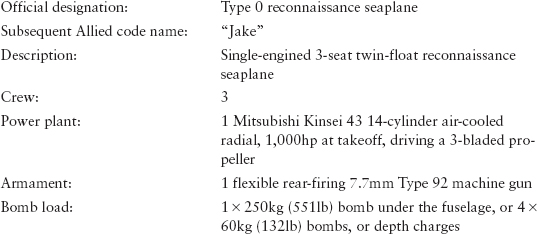
Dimensions
Span: |
47ft 6in |
Length: |
37ft 0in |
Height: |
24ft 3in |
Weight
Empty: |
5,825lb |
Loaded: |
8,025lb |
Maximum speed: |
234mph at 7,155ft |
Cruising speed: |
138mph at 6,560ft |
Climb: |
9,845ft in 6min 5sec |
Service ceiling: |
28,640ft |
Range: |
1,128nm |
NOTES: Designed as a replacement for the Kawanishi E7K2 in the late 1930s, this aircraft went into production in early 1941 and was eventually produced in greater numbers than any other Japanese floatplane. Its outstanding feature was an endurance of almost fifteen hours. Operating from battleships, cruisers, and seaplane tenders, it participated in the navy’s aerial assault on railways and antishipping patrols along the south China coast in late 1941 and flew reconnaissance missions during the navy’s Hawai’ian operation.
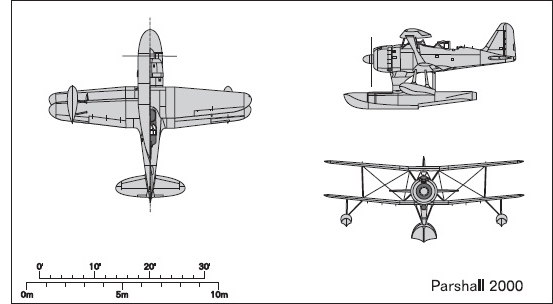
Fig. A6-19. Yokosuka E14Y1 Type 0 small reconnaissance seaplane
Yokosuka E14Y1
Official designation: |
Type 0 small reconnaissance seaplane |
Subsequent Allied code name: |
“Glen” |
Description: |
Single-engined 2-seat submarine-borne twin-float reconnaissance seaplane |
Crew: |
2 |
Power plant: |
1 Hitachi Tempu 12 9-cylinder air-cooled radial, 340hp at takeoff, driving a 2-bladed propeller |
1 flexible rear-firing 7.7mm Type 92 machine gun |
|
Bomb load: |
60kg (132lb) of bombs |

Dimensions
Span: |
36ft 1in |
Length: |
28ft 0in |
Height: |
12ft 5in |
Weight
Empty: |
2,469lb |
Loaded: |
3,197lb |
Performance
Maximum speed: |
153mph at sea level |
Cruising speed: |
104mph at 3,280ft |
Climb: |
9,845ft in 10min 11sec |
Service ceiling: |
17,780ft |
Range: |
476nm |
NOTES: This small seaplane, designed to be carried aboard the navy’s largest submarines for reconnaissance purposes, could be easily disassembled for storage in a watertight hangar aboard the submarine. It had two noteworthy appearances during the Pacific War. The first was its dawn reconnaissance over Pearl Harbor on 17 December 1941 to assess the damage inflicted by the navy’s earlier attack on the warships and facilities there. The second was an attempt by an E14Y1, flying off a submarine, to firebomb the Oregon forests in August 1942, the only time Japanese forces ever struck at the American mainland.
Fig. A6-20. Nakajima A6M2-N Type 2 seaplane fighter
Nakajima A6M2-N
Official designation: |
Type 2 seaplane fighter |
Subsequent Allied code name: |
“Rufe” |
Description: |
Single-engined single-seat float seaplane fighter |
Crew: |
1 |
Power plant: |
1 Nakajima NK1C Sakae 12 14-cylinder air- cooled radial, 940hp at takeoff, driving a 3-bladed propeller |
Armament: |
2 × 7.7mm Type 97 machine guns and 2 × 20mm Type 99 cannon |
Bomb load: |
2 × 60kg (132lb) bombs |
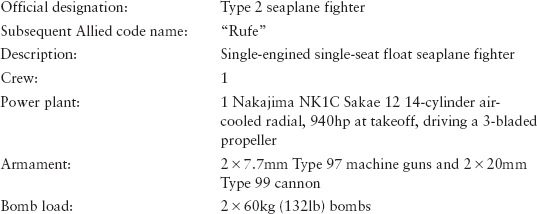
Dimensions
Span: |
39ft 4in |
Length: |
33ft 1in |
Height: |
14ft 1in |
Weight
Empty: |
4,235lb |
Loaded: |
5,423lb |
Performance
Maximum speed: |
270mph at 16,405ft |
184mph at 16,405ft |
|
Climb: |
16,405ft in 6min 43sec |
Service ceiling: |
32,810ft |
Range: |
620nm (963nm max) |
NOTES: This aircraft was conceived by the navy in 1940 as a single-seat fighter seaplane to provide air cover in the early stages of amphibious landings in the Japanese offensives in Southeast Asia and the southwestern Pacific, or on small islands, such as Tulagi in the Solomons, where construction of airfields was not practical. Under navy instructions it was produced by Nakajima as a floatplane version of the Mitsubishi A6M2. In this offensive role it served effectively at the outset of the Pacific War, but functioning defensively as an interceptor when the tide of war turned against Japan, it was hardly a match for land-based Allied fighters.
FLYING BOATS
Kawanishi H6K4
Official designation: |
Type 97 flying boat |
Subsequent Allied code name: |
“Mavis” |
Description: |
4-engined long-range reconnaissance flying boat; also produced in transport version (H6K2-L and H6K3) |
Crew: |
8 |
Power plant: |
4 Mitsubishi Kinsei 46 14-cylinder air-cooled radials, 930hp at takeoff, driving 3-bladed propellers |
Armament: |
1 flexible 7.7mm Type 92 machine gun in an open bow position, 1 flexible 7.7mm Type 92 machine gun in an open dorsal position, 1 × 7.7mm Type 92 machine gun in each beam blister, and 1 flexible 20mm Type 99 Model 1 cannon in a tail turret |
Bomb load: |
2 × 800kg (1,764lb) torpedoes or up to 1,000kg (2,205lb) of bombs |
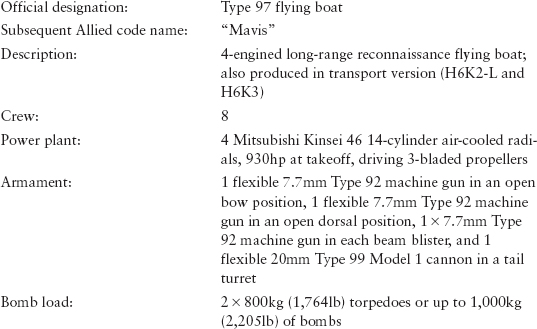
Dimensions
Span: |
131ft 2in |
Length: |
84ft 0in |
Height: |
20ft 6in |
Fig. A6-21. Kawanishi H6K4 Type 97 flying boat
Weight
Empty: |
25,810lb |
Loaded: |
37,479lb |
Performance
Maximum speed: |
211mph at 13,125ft |
Cruising speed: |
138mph at 12,125ft |
Climb: |
16,405ft in 13min 31sec |
Service ceiling: |
31,530ft |
Range: |
2,590nm (3,283nm max) |
NOTES: The H6K4 (Type 97 Model 2-2) was the major production version of this aircraft at the beginning of the Pacific War. Earlier variants included H6K2 and H6K3.
Official designation: |
Type 2 flying boat |
Subsequent Allied code name: |
“Emily” |
Description: |
4-engined long-range reconnaissance flying boat |
Crew: |
9 |
Power plant: |
4 Mitsubishi MK4A Kasei 12 14-cylinder air- cooled radials, 1,530hp at takeoff, driving 4- bladed propellers |
Armament: |
20mm Type 99 Model 1 cannon in dorsal and tail turrets, and 7.7mm Type 92 machine guns in 2 beam blisters, ventral and cockpit hatches, and bow turret |
Bomb load: |
2 × 800kg (1,764lb) torpedoes, or 8 × 250kg (551lb) bombs, or 16 × 60kg (132lb) bombs, or depth charges |

Dimensions
Span: |
124ft 8in |
Length: |
92ft 3in |
Height: |
30ft 0in |
Weight
Empty: |
34,176lb |
Loaded: |
54,013lb |
Performance
Maximum speed: |
269mph at 16,405ft |
Cruising speed: |
184mph at 13,145ft |
Climb: |
16,405ft in 14min 33sec |
Service ceiling: |
25,035ft |
Range: |
3,888nm |
NOTES: The first production versions of this aircraft were just being delivered as war broke out.
Fig. A6-22. Kawanishi H8K1 Type 2 flying boat
Mitsubishi G3M2 Model 22
Official designation: |
Type 96 attack bomber |
Subsequent Allied code name: |
“Nell” |
Description: |
Twin-engined land-based bomber; transport variant (L3Y) also produced |
Crew: |
7 |
Power plant: |
2 Mitsubishi Kinsei 42 14-cylinder air-cooled radials, 1,075hp at takeoff, driving either 4-bladed fixed-pitch propellers or 3-bladed variable-pitch propellers; or 2 Mitsubishi Kinsei 45 14-cylinder air-cooled radials, 1,075hp at takeoff, driving 3- bladed variable-pitch propellers |
Armament: |
1 flexible 20mm Type 99 Model 1 cannon in a dorsal turret, and 1 flexible 7.7mm Type 92 machine gun in each of the beam blisters and a retractable dorsal turret; a flexible 7.7mm Type 92 machine gun could also be fired from the cockpit windows |
Bomb load: |
1 × 800kg (1,764lb) torpedo or 800kg (1,764lb) of bombs carried externally |
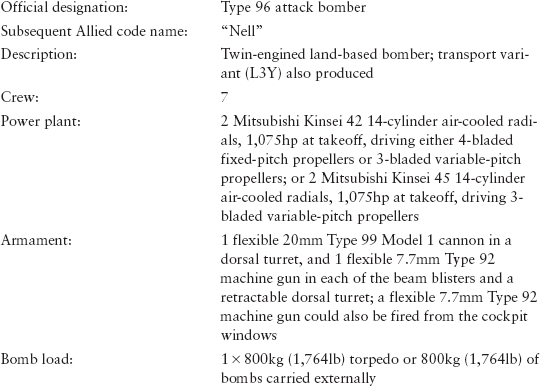
Dimensions
Span: |
82ft 0in |
Length: |
53ft 11in |
Height: |
12ft 1in |
Weight
Empty: |
10,936lb |
Loaded: |
17,637lb |
Performance
Maximum speed: |
232mph at 13,715ft |
Cruising speed: |
173mph at 13,125ft |
Climb: |
9,845ft in 8min 19sec |
Service ceiling: |
29,950ft |
Range: |
2,365nm |
Fig. A6-23. Mitsubishi G3M2 Model 22 Type 96 attack bomber
Official designation: |
Type 1 attack bomber |
Subsequent Allied code name: |
“Betty” |
Description: |
Twin-engined land-based bomber |
Crew: |
7 |
Power plant: |
2 Mitsubishi MK4A Kasei 11 14-cylinder air- cooled radials, 1,530hp at takeoff, driving 3- bladed propellers; or 2 Mitsubishi MK4E Kasei 15 14-cylinder air-cooled radials, 1,530hp at takeoff, driving 3-bladed propellers |
Armament: |
7.7mm Type 92 machine guns in nose, dorsal blister, and beam blister positions, and 20mm Type 99 Model 1 cannon in tail turret |
Bomb load: |
1 × 800kg (1,764lb) torpedo or 800kg (1,764lb) of bombs carried internally |

Dimensions
Span: |
82ft 0in |
Length: |
65ft 7in |
Height: |
19ft 8in |
Weight
Empty: |
14,991lb |
Loaded: |
20,944lb |
Performance
Maximum speed: |
276mph at 13,780ft |
Cruising speed: |
196mph at 9,845ft |
Climb: |
22,965ft in 18min |
Service ceiling: |
30,000ft (approx) |
Range: |
3,256nm |